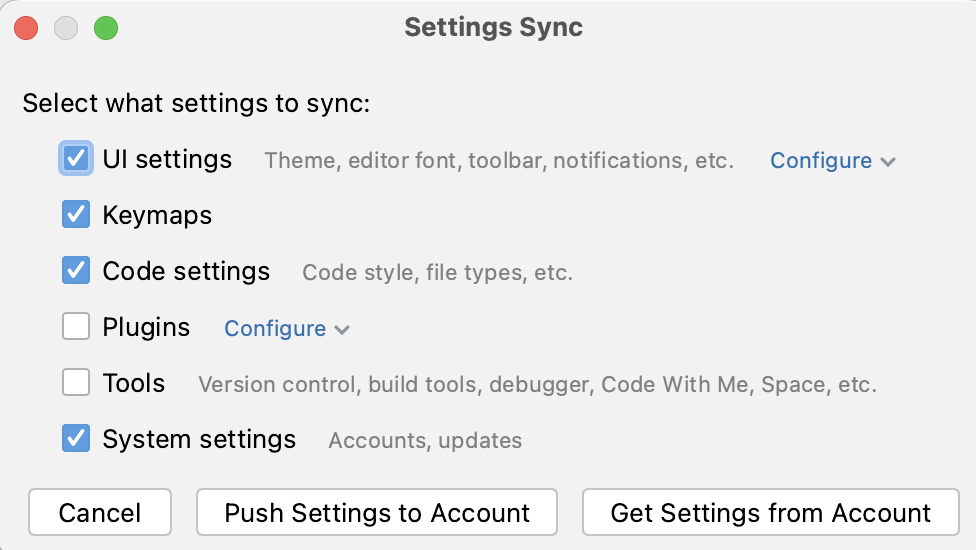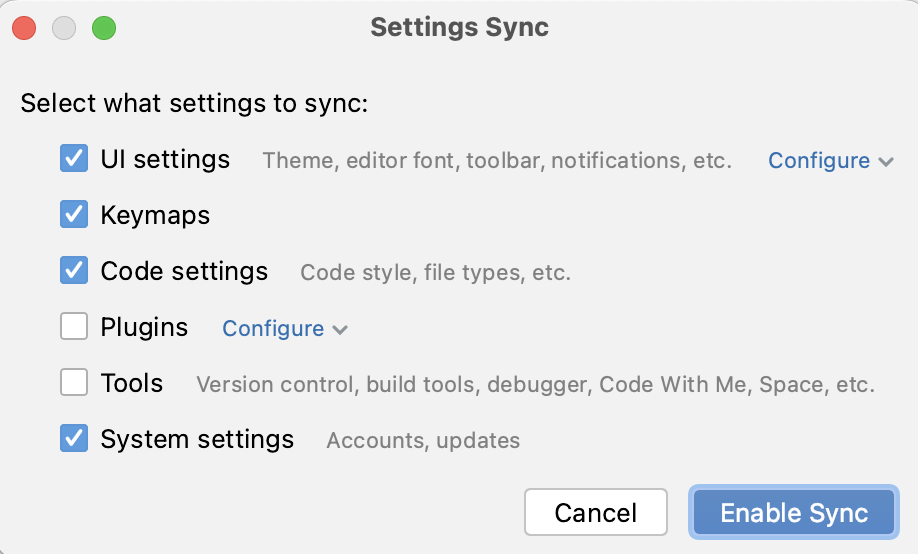Share IDE settings
DataSpell lets you share your IDE settings between different instances of the product, or among your team members. This helps you recreate a comfy working environment if you are working from different computers and spare the annoyance of things looking or behaving differently from what you are used to, or enforce the same standards throughout your team.
You can share your IDE settings by using one of the following:
Settings Sync: it utilizes the JetBrains server, so no additional configuration is required. Synced settings are linked to your JetBrains Account and are available in all IDEs where you log in using this account.
The settings you can sync include: IDE themes, keymaps, color schemes, system settings, UI settings, menus and toolbar settings, project view settings, editor settings, code completion settings, parameter name hints, live templates, code styles, and the list of enabled and disabled plugins.
Settings Repository: it allows you to sync any configurable components (except for the list of enabled and disabled plugins) but requires setting up a Git repository with the settings you want to share.
This option is useful if you want to implement the same settings among your team-members or to use you use your custom settings storage.
note
Starting from version 2022.3, the Settings Repository plugin is not bundled with DataSpell. It is still available for installation in JetBrains Marketplace. For information on how to set up Settings Repository, refer to version 2022.2 of DataSpell documentation.
Exporting the settings you want to share as a ZIP archive and then importing them to a different IDE installation. You can export your code style settings, Git settings, including registered GitHub accounts, the Debugger settings, Registry keys, look and feel, and more.
The IDE Settings Sync plugin was deprecated in DataSpell 2022.3. Instead, a new plugin, Settings Sync, is available and bundled in DataSpell 2022.3. The most notable changes include:
The new plugin supports synchronization across all JetBrains IDEs.
Settings Sync synchronizes the settings of plugins, including those of third-party plugins (plugin developers should enable it if they want the settings of their plugin to be synchronized by Settings Sync).
warning
If you have enabled Settings Repository, you cannot share your settings through Settings Sync.
On the computer with the IDE instance containing the settings you want to share, sign in to either of the following:
Your IDE: from the main menu choose Help | Register, choose to activate your license with the JetBrains Account and enter your credentials.
Toolbox App: click the gear icon
 in the top right corner of the application, select Settings and click Log in. Note that by signing in to Toolbox App, you automatically sign in to all JetBrains products that you run.
in the top right corner of the application, select Settings and click Log in. Note that by signing in to Toolbox App, you automatically sign in to all JetBrains products that you run.If, instead of the JetBrains account, you use an activation code or a license server to activate your DataSpell, press CtrlAlt0S to open the IDE settings and select Settings Sync | Log in with JetBrains account to sign in to your JetBrains account.
Press CtrlAlt0S to open Settings, go to Settings Sync, and then click Enable Settings Sync.

tip
You can also enable and disable Settings Sync or access its settings by right-clicking the gear icon
in the upper-right corner of the DataSpell window.
In the Settings Sync window that opens, select the setting categories that you want to share.
note
You can exclude some settings from synchronization by clicking Configure next to the settings. For example, you can exclude specific plugins if you do not want to sync them. Or you may want to keep local fonts for the editor instead of synchronizing them if your IDEs are installed on different operating systems where some fonts can be missing.
The following step depends on whether there are synced settings linked to your JetBrains Account.
Synced settings availableNo synced settings
Click Push Settings to Account to override the settings stored on the JetBrains server with your local settings and use them as the shared ones.

Click Enable Sync.
In a different IDE instance where you want these settings to be applied, open Settings CtrlAlt0S, go to Settings Sync, and then click Enable Settings Sync.
In the Settings Sync window that opens, select Get Settings from Account.
Your local settings will be automatically synchronized with the settings stored on the JetBrains server each time you modify a setting and each time the JetBrains server receives setting updates from another IDE.
By default, your settings are synchronized across instances of the same IDE product only, for example, across your DataSpell instances. You can enable synchronization of settings across any IntelliJ-based IDE products where the Settings Sync plugin is enabled and where you log in using the same JetBrains account.
Open the Settings dialog (CtrlAlt0S) and go to Settings Sync.
In the Sync settings across list select All JetBrains IDE products.

You can either disable settings synchronization for a single IDE or completely remove all settings from the JetBrains cloud server and disable synchronization for all IDEs connected to your JetBrains account.
Press CtrlAlt0S to open Settings, go to Settings Sync, and then click Disable Settings Sync.
Confirm disabling settings synchronization. To disable synchronization on all of your IDEs, select Remove data from JB account and disable for all IDEs.
This section attempts to answer questions that you may have while using setting synchronization after the upgrade from DataSpell 2022.2 (or earlier) to DataSpell 2022.3.
- I was using IDE Settings Sync in 2022.2 (or earlier). What will happen to my settings?
The settings will be migrated to the new Settings Sync plugin after you upgrade your IDE to 2022.3.
- If I do not upgrade one of my IDE instances to 2022.3, will its settings be synchronized with the settings of those IDEs that I upgrade to 2022.3?
No. The new Settings Sync plugin synchronizes settings across IDEs version 2022.3 and later.
- Will Settings Repository be available in 2022.3?
Yes. The Settings Repository plugin is not bundled in 2022.3, but you can still install it manually.
- I use Settings Repository. What are my options after the upgrade to 2022.3?
Just as before, you cannot use Settings Repository and Settings Sync simultaneously. That is why, if you use Settings Repository, we won't automatically enable the new Settings Sync after you upgrade to 2022.3. Instead, we will let you choose your preferred way to synchronize settings: You can either manually install Settings Repository or enable the new Settings Sync.
- I have to use a custom storage for settings. What are my options?
Settings Sync stores settings on the JetBrains cloud server and currently does not provide a way to set up a custom storage. If you absolutely need a custom server to store settings, you can manually install Settings Repository and continue using it in 2022.3.
- Is Settings Sync enabled by default?
No. However, it is automatically enabled if you have enabled the old IDE Settings Sync in your 2022.2 IDE and then upgraded it to 2022.3.
- Does Settings Sync support synchronization of plugin settings?
Yes, but it should also be supported by the plugin itself. For more info, refer to IntelliJ Platform SDK documentation.
- I have two IDE instances, and each of them is connected to a separate JetBrains Account. Can I synchronize settings across them?
In Settings Sync, your settings are linked to the JetBrains Account that you use to log in to the IDE. You can link multiple email addresses to your account. This will allow you to log in to both of your IDEs using the same account and thus share your settings across all of them.
Thanks for your feedback!